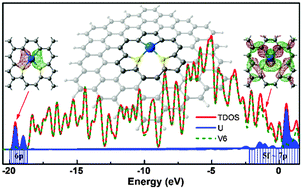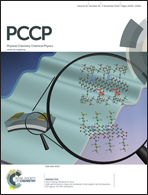Defect-induced strong localization of uranium dicarbide on the graphene surface†
Abstract
Defects such as the most stable hexavacancy (V6) distribute widely on neutron-irradiated graphite surfaces, which play a dominant role in immobilizing radioactive products released from nuclear fuels. By performing DFT calculations, we explore the interaction of gaseous uranium dicarbide (UC2) molecules on a graphene nanosheet with a V6 defect, in order to investigate the behavior of the representative vapor species of uranium carbide fuels in reactor cores. Results suggest that UC2 can be trapped in the V6 defect with considerable binding energy of >10 eV, with all the six dangling bonds of the V6 defect being saturated by UC2. Bonding nature analyses also reveal that the U–C interaction lies in the synergistic interplay between electrostatic and covalent interaction with extensive participation of U valence electrons from 5f to 7p orbitals, which further stimulate polarization of semi-core 6p orbitals and their subsequent contributions to the bonding. This strong interaction leads to a favorable binding of UC2 to the defective graphite surface, which reduces the capability of nuclear graphite to retain harmful fission products by the vacancies being filled with UC2. These findings highlight substantial chemical reactivity and strong localization of UC2 on the widespread V6 defects in nuclear graphite, and may provide an important reference in establishing modern nuclear reactor safety at the atomic level.



 Please wait while we load your content...
Please wait while we load your content...